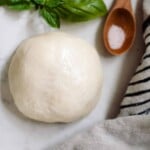
Homemade Mozzarella Cheese
Creamy, salty, all the best things when it comes to cheese. Learn how to make easy and delicious homemade mozzarella cheese in just 30 minutes.
Servings 8
Calories 287kcal
Ingredients
- 1 1/2 teaspoons citric acid
- 1/4 teaspoon animal rennet
- 1/2 cup water divided
- 1 gallon whole milk
Instructions
- In a small bowl, add the citric acid and 1/4 cup of the water. Stir to dissolve.
- In a separate small bowl, mix together the remaining 1/4 cup of water and rennet. Set aside.
- Pour the citric acid mixture into a large pot.
- Add the milk to the pot and heat over medium, stirring constantly to incorporate the citric acid.
- Once the milk and citric acid mixture reaches 100° F, using a digital thermometer, remove the pot from the heat. If you are using a gas stove, it is fine to leave the pot on the burner as long as the flame is off.
- Add the rennet/water mixture into the pot of milk. Mix well, making sure to get it all the way to the bottom of the pot, while not agitating it too much. Sometimes I stir clockwise and then quickly switch to counter-clockwise to still the milk. You want the milk to be pretty still for the next step.
- Put a lid on the pot and allow it to sit for ten minutes, or until the curds have set. If tak off the lid and it looks like the milk is still pretty watery, you can return the lid and do some other tasks around the kitchen.
- Once the curds have set, cut them using a large knife, while making sure to get all the way down to the bottom of the pot. Cut in a grid shape.
- Pour the curds and whey into a colander over a pot, straining off the whey. If you aren’t planning to use the whey for anything, you’ll want to save a little bit of the whey for storing the cheese.
- Press out any excess whey with your hands.
- Continue pressing until all the of the whey is out of the cheese.
- Once the ball of cheese forms and the whey is pressed out, dip the cheese back into hot water and stretch it. (You could also heat it up in a microwave.) I usually dunk the cheese into the hot water and stretch, continuing to do this until the cheese because firm and shiny.
- Stretch it a few more times and add salt to taste. I like to hold the cheese with one hand and then sprinkle over the salt in another hand. Fold the cheese over, stretch a few times and add more salt.
- Roll into balls and use it right away or store for later.
Notes
- Fresher milk seems to make the cheese a little prettier when heating and cutting the curds, whereas slightly older milk will work just fine (not spoiled), but looks a little funny in the pot.
- I like to heat my milk to around 100 degrees to help keep some of the beneficial things in the raw milk intact. Heating it too high will kill all the glories of raw milk.
- Do not mix the milk too much after the rennet is added. You want to bring the spoon up and down rather than mixing in a circle.
- You can pour the citric acid and the liquid animal rennet right into the milk, but I find it easier to work with if it is already dissolved.
Nutrition
Calories: 287kcal | Carbohydrates: 22g | Protein: 16g | Fat: 15g | Saturated Fat: 9g | Polyunsaturated Fat: 1g | Monounsaturated Fat: 3g | Cholesterol: 57mg | Sodium: 181mg | Potassium: 710mg | Sugar: 23g | Vitamin A: 767IU | Calcium: 582mg